***For Immediate Release***
April 12, 2018
Contact, Jeff Sheldon
Communications Director, Nebraska Appleseed
Cell: (402) 840-7289
Email: jsheldon@neappleseed.org
SNAP cuts proposed in draft Farm Bill would hurt thousands of Nebraska families
New restrictions on food assistance will take meals off the table, plunge more Nebraskans into poverty
LINCOLN — The 2018 Farm Bill introduced today by the House Agriculture Committee proposes new punitive barriers to the nation’s most-essential food assistance initiative, the Supplemental Nutrition Assistance Program (SNAP), which helps 1 in 11 Nebraskans afford the meals they need.
Today, Nebraska advocates who support opportunity for low-income families and children’s health decried the Farm Bill proposal as a dangerous threat to Nebraska families who already struggle to afford basic meals.
“Nebraska’s values demand that we make sure our children and our neighbors are not going hungry,” Nebraska Appleseed Economic Justice Director James Goddard said. “This Farm Bill would result in drastic cuts to SNAP and contains other dangerous provisions that will take food off the table for thousands of hard-working Nebraska families who struggle to afford basic meals.”
“Many people believe that food banks and pantries should and can provide sufficient food for hungry families, said Susan Ogborn, President and CEO of Food Bank for the Heartland. “That is, unfortunately, not true. Every food bank and every pantry combined across the United States only provide 8.3 percent of the food that SNAP provides each year.”
“Hunger in childhood is harmful to proper development and a threat to our collective future as a state,” said Julia Tse, Voices for Children in Nebraska’s Policy Coordinator for Economic Stability and Health. “These proposed changes to SNAP would have a disastrous impact for the 88,500 children currently receiving SNAP in Nebraska.”
SNAP has been a proven success in Nebraska, helping struggling families – most of whom have children – afford a basic diet. Thousands of Nebraskans turn to SNAP when they hit tough times or are struggling to get by on low wages. Last November, a group of 12 Nebraska organizations urged Congress to strengthen, not weaken food assistance programs in federal budget discussions.
Facts about SNAP in Nebraska:
- 176,000 Nebraskans receive essential food assistance from SNAP.
- 82 percent of Nebraskans who receive SNAP are at or below the Federal Poverty Level (about $20,780 per year for a family of three)
- More than 75 percent of Nebraska’s SNAP recipients are children, 27 percent are in families which have people with disabilities, and more than 53 percent are in families with one employed member.
- Nebraskans participating in SNAP are most commonly in service, office or production jobs. Most are paid hourly wages far below the state average.
- SNAP helps families in every part of Nebraska. 9.2 percent of Nebraskans who live in small towns receive SNAP, as well as 7.3 percent of people who live in rural areas, and 9.4 percent of people who live in one of Nebraska’s metro areas.
“These proposed cuts and new barriers to SNAP will take away people’s food and should not be part of the Farm Bill,” Goddard said. “Congress should be focusing on job creation and boosting wages for hard-working Nebraskans rather than doing real damage to people who are already facing tough times.”
Research by the Center on Budget and Policy Priorities shows SNAP has lifted 34,000 Nebraskans out of poverty each year, making it one of our country’s most-effective poverty-fighting tools.
SNAP also is an important economic boost to Nebraska’s local economies. Every increase of $1.00 in SNAP spending increases real GDP by $1.73. SNAP dollars go directly to Nebraska’s local grocery stores and markets, and the current structure of SNAP makes it flexible to allow states to respond to unpredictable obstacles like natural disasters or a recession.
# # #
